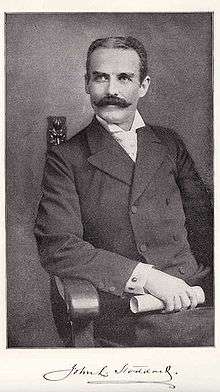John Lawson Stoddard
| John Lawson Stoddard | |
|---|---|
 | |
| Born |
April 24, 1850 Brookline, Massachusetts, USA |
| Died | June 5, 1931 (aged 81)[1] |
| Education | Williams College & Yale Divinity School |
John Lawson Stoddard (April 24, 1850 – June 5, 1931) was an American writer, hymn writer and lecturer who gained popularity through his travelogues.
Biography
Stoddard was born in Brookline, Massachusetts, in 1850. In 1871 he graduated from Williams College. At Williams he was a member of the fraternity Delta Psi (aka St. Anthony Hall). Later he studied two years of theology at Yale Divinity School. After that he taught Latin and French at Boston Latin School.[2] He was proud of his descent from Solomon Stoddard.
He began traveling around the world in 1874 and published Red-Letter Days Abroad in 1884. He turned his experiences into a series of popular lectures delivered throughout North America. These lectures were periodically published in book form as John L. Stoddard's Lectures and eventually numbered 10 volumes and five supplements (1897-1898).[3] In 1901, Stoddard published a book on Gibraltar.[4] The books include numerous illustrations derived from the immense catalog of photographs taken by Stoddard, and cover every subject, from art and architecture, to archaeology and natural history. The books were immensely popular in their day and many copies still survive. Later in life, Stoddard also published poetry, as well as books on religious subjects.
Brought up a Protestant, Stoddard was an agnostic for more than 30 years before converting with his wife to Roman Catholicism. In 1922 he published Rebuilding a Lost Faith, a famous work of apologetics which is still in print.

Stoddard was a proponent of the restoration of the Jews to Israel. In Volume 2 of his Lectures he told the Jews, “You are a people without a country; there is a country without a people. Be united. Fulfill the dreams of your old poets and patriarchs. Go back, go back to the land of Abraham.”[5] A sentiment popularized as "A land without a people for a people without a land." However, his son Lothrop Stoddard, who remained agnostic after his father's conversion,[6][7] held antisemitic views.[8]
During his later life he used his fortune to support his adopted home of Merano, South Tyrol, contributing substantially to the building of its secondary school and to a home for homeless youth, now used as a rehabilitation center.
John L. Stoddard's Lectures
- v. 1 Norway. Switzerland. Athens. Venice.
- v. 2 Constantinople. Jerusalem. Egypt.
- v. 3 Japan (two lectures). China.
- v. 4 India (two lectures). The Passion play.
- v. 5 Paris. La belle France. Spain.
- v. 6 Berlin. Vienna. St. Petersburg. Moscow.
- v. 7 The Rhine. Belgium. Holland. Mexico.
- v. 8 Florence. Naples. Rome.
- v. 9 Scotland. England. London.
- v. 10 Southern California. Grand cañon of the Colorado River. Yellowstone National Park.
- v. 11 Photographs - Portfolio of Photographs - Photographic view of the entire world of nature and art, the old and new world (256 photos).
Supplementary volumes:
- no. 1 Ireland (two lectures). Denmark. Sweden.
- no. 2 Canada (two lectures). Malta. Gibraltar.
- no. 3 South Tyrol. Around Lake Garda. The Dolomites.
- no. 4 Sicily. Genoa. A drive through the Engadine.
- no. 5 Lake Como. The upper Danube. Bohemia.
Notes
- ↑ Birth and death dates taken from American Authors and Books.
- ↑ Dates and schooling from the biographical material in John L. Stoddard's Lectures, 1905.
- ↑ Book dates taken from American Authors and Books.
- 1 2 Stoddard, John L. (1901). Gibraltar - John L. Stoddard's Lectures. Norwood Press.
- ↑ Stoddard, John L. (1897). Lectures, Vol. 2: Constantinople. Jerusalem. Egypt. Boston: Balch Brothers Co., p. 113.
- ↑ The color of race in America, 1900-1940 by Matthew Pratt Guterl, pg 51
- ↑ Race: the history of an idea in America by Thomas F. Gossett, pg 390
- ↑ Science for segregation: race, law, and the case against Brown v. Board of ... by John P. Jackson, pg 21
References
- John L. Stoddard's Lectures (1905)
- American Authors and Books: 1640 to Present Day Third Revised Edition, Crown Publishers, Inc., New York. (Original Editors W. J. Burke and Will D. Howe)
Further reading
- John L. Stoddard by D. Crane Taylor (1935).
External links
| Wikimedia Commons has media related to John Lawson Stoddard. |
- Works by John Lawson Stoddard at Project Gutenberg
- Works by or about John Lawson Stoddard at Internet Archive
- John Lawson Stoddard (1899). Lectures, Illustrated and Embellished with Views of the World's Famous ... Balch.